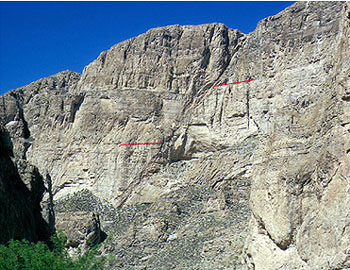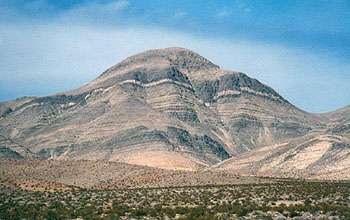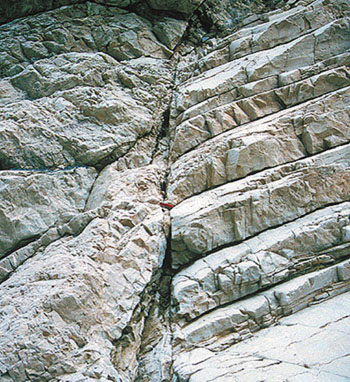Normal Faults
| To correctly identify a fault, you must first figure out which block is the footwall and which is the hanging wall. Then you determine the relative motion between the hanging wall and footwall. Every fault tilted from the vertical has a hanging wall and footwall. To determine which is which, visualize yourself creating a mine in along the fault plane. The block below your feet is the footwall, and the one upon which you would hang your miner's lamp is the hanging wall. It is that simple. Strike-slip faults are vertical and thus do not have hanging walls or footwalls.
If the hanging wall drops relative to the footwall, you have a normal fault. Normal faults occur in areas undergoing extension (stretching). If you imagine undoing the motion of a normal fault, you will undo the stretching and thus shorten the horizontal distance between two points on either side of the fault. |
|
If you stood on the fault plane, the block on the right would be under your feet. This is thus the footwall.
The red line marks equivalent layers on opposite side of the fault. Since the hanging wall dropped relative to the footwall, this is clearly a normal fault.
Photo: Thick limestone beds in northerm Mexico, by Norris W. Jones
|

|
|
The striking black layer is a welded tuff (volcanic ash that remelted itself to become solid glassy rock). There are three normal faults in the pink tuffs to the right of the welded tuff. At the feet of the person is the same orange layer as the faulted one seen just above the road in the middle of the photo. A second fault cuts the orange layer in the middle of the photo. A third one runs from the left end of this faulted layer down to the person.
|

|
|
Normal faults often occur in pairs, with one being the main fault and the other being a smaller conjuagate fault.
The red lines show the offset on the right-hand fault. Given the angle of the fault, the upper red line is on the footwall, the lower red line is on the hanging wall.
Bishop Tuff lake sediments, Owen Valley, CA.
|

|
|
This mountain of nicely layers limestones shows several sets of normal faults offsetting the prominent white band near the top of the mountain. If you focus on each fault, the offset of each hanging wall from each foot wall indicates normal fault motion.
Near the Race Track, Death Valley, CA
|

|
|
Many normal faults have so much offset that you cannot trace individual beds across a single outcrop. However, sometimes the beds have been bent by the dragging of the hanging wall over the footwall.
In this case, the beds on the right of this fault have been bent downwards by normal fault motion.
Mosaic Canyon, Death Valley, CA
|

|
|

![]()




